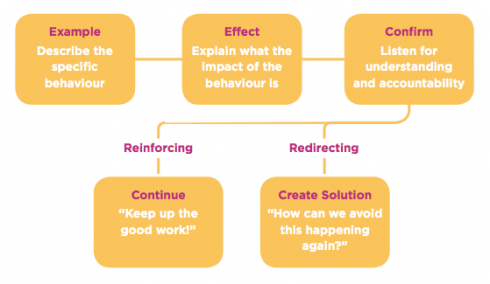The sharing of effective feedback should happen all the time in teams. In fact, giving or not giving recognition or praise for doing good work is responsible for a 10 – 20% difference in revenue and productivity. However, many managers find its one of the most challenging parts of their role.
Most of us have had unpleasant experiences being on the receiving end of ‘feedback’, we’ve come to associate it with sometimes receiving harsh, unfair and often heated personal attacks. The good news is that it doesn’t have to be like this. With a few simple techniques and some clarified expectations, you can turn feedback into a normal and every day part of work life.
Our recipe for giving feedback is the “EECC” (example, effect, confirm, continue or create) framework. Like all recipes you should alter to best fit your own communication style, situation and experience.

Example – The specific behavior
Identify the specific topic or issues that the feedback will be about. What happened, where and when it happened and who was involved. The key point here is that the example is focused on their behavior – not their attitude.
Effect – The impact of the behavior
What the impact is and what the scale of the impact is. You can reference the effect that it’s had on the team achieving their goals, other working customers and so on. It is this step that is typically left out – which leads to the receiver being confused about the relevance of their good or bad behavior.
Confirm – Listen for understanding and accountability
It’s now time to listen to check that you’ve being understood and the person is receiving the information in a way that is going to be effective. It’s important to be open, just as you want your employee to be willing to be influenced by what they hear then so should you. Each story has two sides and your goal is to get a complete and accurate understanding of the situation or event to avoid the situation in the future.
Continue – Keep up the good work
The fun part! Remember that it’s important that the reward is tailored both to the size of the achievement and to the preferences of the employee. Some may value face time with the CEO, others may prefer finishing early to spend time with their family. Money tends to be less effective than gratitude and recognition. We all have powerful lessons to learn from success, so find out how they did it and if there are any lessons that can be shared.
Create – How can we avoid this situation again?
Encourage the person to co-create a solution. You may do this by posing questions like “How can we avoid this happening again”? Keep an eye out for improvements to reinforce. Even small steps towards improvement in behavior should be commented on positively!
Tip: Where possible avoid giving positive and negative feedback at the same time! Never say something nice, then use words like “but”, or “however”. This makes the receiver think you’ve simply built them up to break ‘em back down again!
See all posts